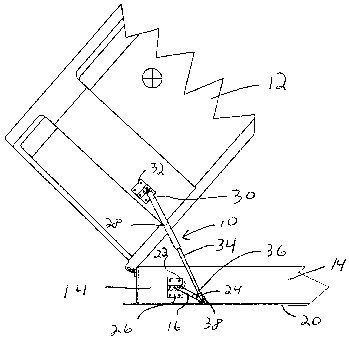Some of the information on this Web page has been provided by external sources. The Government of Canada is not responsible for the accuracy, reliability or currency of the information supplied by external sources. Users wishing to rely upon this information should consult directly with the source of the information. Content provided by external sources is not subject to official languages, privacy and accessibility requirements.
Any discrepancies in the text and image of the Claims and Abstract are due to differing posting times. Text of the Claims and Abstract are posted:
| (12) Patent: | (11) CA 2463334 |
|---|---|
| (54) English Title: | LIFT ASSIST MECHANISM FOR LIFTING LARGE ENCLOSURES |
| (54) French Title: | MECANISME FACILITANT LE LEVAGE DE GROSSES ENCEINTES |
| Status: | Term Expired - Post Grant Beyond Limit |
| (51) International Patent Classification (IPC): |
|
|---|---|
| (72) Inventors : |
|
| (73) Owners : |
|
| (71) Applicants : |
|
| (74) Agent: | FINLAYSON & SINGLEHURST |
| (74) Associate agent: | |
| (45) Issued: | 2009-12-15 |
| (22) Filed Date: | 2004-04-06 |
| (41) Open to Public Inspection: | 2004-11-09 |
| Examination requested: | 2009-04-03 |
| Availability of licence: | N/A |
| Dedicated to the Public: | N/A |
| (25) Language of filing: | English |
| Patent Cooperation Treaty (PCT): | No |
|---|
| (30) Application Priority Data: | ||||||
|---|---|---|---|---|---|---|
|
A lift assist mechanism for lifting a large enclosure that is pivotally attached to a body member, between a closed position, an intermediate position, and an open position. The lift assist mechanism includes a swing arm member and an expansible strut member. The swing arm member is pivotally attached to the body member at a first end and to a first end of the strut member at the second end. The second end of strut member is pivotally attached to the enclosure member. The pivot point between the swing arm member and the strut member pushes against a base plate associated with the body member when the enclosure member is in its closed and intermediate positions.
Mécanisme facilitant le levage permettant de soulever une grande enceinte qui est fixée de façon pivotante à un élément de corps, entre une position fermée, une position intermédiaire et une position ouverte. Le mécanisme facilitant le levage comprend un élément de bras oscillant et un élément d'entretoise expansible. Le bras oscillant est fixé de manière pivotante à l'élément de corps à une première extrémité et à une première extrémité de l'élément d'entretoise au niveau de la seconde extrémité. La seconde extrémité de l'élément d'entretoise est fixée de manière pivotante à l'élément d'enceinte. Le point de pivotement entre le bras de pivotement et l'élément d'entretoise bute contre une plaque de base associée à l'élément de corps lorsque ladite enceinte est en position fermée et intermédiaire.
Note: Claims are shown in the official language in which they were submitted.
Note: Descriptions are shown in the official language in which they were submitted.

2024-08-01:As part of the Next Generation Patents (NGP) transition, the Canadian Patents Database (CPD) now contains a more detailed Event History, which replicates the Event Log of our new back-office solution.
Please note that "Inactive:" events refers to events no longer in use in our new back-office solution.
For a clearer understanding of the status of the application/patent presented on this page, the site Disclaimer , as well as the definitions for Patent , Event History , Maintenance Fee and Payment History should be consulted.
| Description | Date |
|---|---|
| Inactive: Expired (new Act pat) | 2024-04-08 |
| Inactive: IPC assigned | 2022-08-08 |
| Common Representative Appointed | 2019-10-30 |
| Common Representative Appointed | 2019-10-30 |
| Inactive: IPC expired | 2017-01-01 |
| Grant by Issuance | 2009-12-15 |
| Inactive: Cover page published | 2009-12-14 |
| Pre-grant | 2009-09-25 |
| Inactive: Final fee received | 2009-09-25 |
| Notice of Allowance is Issued | 2009-07-13 |
| Letter Sent | 2009-07-13 |
| Notice of Allowance is Issued | 2009-07-13 |
| Inactive: Approved for allowance (AFA) | 2009-06-16 |
| Advanced Examination Requested - PPH | 2009-05-22 |
| Advanced Examination Determined Compliant - PPH | 2009-05-22 |
| Letter Sent | 2009-05-07 |
| Request for Examination Received | 2009-04-03 |
| Request for Examination Requirements Determined Compliant | 2009-04-03 |
| All Requirements for Examination Determined Compliant | 2009-04-03 |
| Inactive: IPC from MCD | 2006-03-12 |
| Inactive: IPC from MCD | 2006-03-12 |
| Inactive: IPC from MCD | 2006-03-12 |
| Application Published (Open to Public Inspection) | 2004-11-09 |
| Inactive: Cover page published | 2004-11-08 |
| Inactive: First IPC assigned | 2004-10-22 |
| Inactive: IPC assigned | 2004-10-22 |
| Inactive: Filing certificate - No RFE (English) | 2004-05-11 |
| Filing Requirements Determined Compliant | 2004-05-11 |
| Letter Sent | 2004-05-11 |
| Application Received - Regular National | 2004-05-11 |
There is no abandonment history.
The last payment was received on 2009-03-18
Note : If the full payment has not been received on or before the date indicated, a further fee may be required which may be one of the following
Please refer to the CIPO Patent Fees web page to see all current fee amounts.
Note: Records showing the ownership history in alphabetical order.
| Current Owners on Record |
|---|
| SMITH & LOVELESS, INC. |
| Past Owners on Record |
|---|
| ANDREW C. MCCULLOUGH |